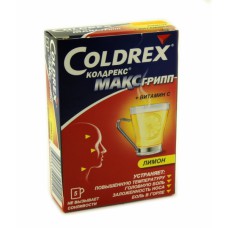Expiration date: 04/2026
Composition and form of issue:
Powder for preparation of solution for the reception inside (lemon), 1 sachet contains active substance:
paracetamol 1000 mg
ascorbic acid 40 mg
phenylephrine hydrochloride 10 mg
excipients: sucrose citric acid sodium citrate maize starch, flavour lemon, sodium cyclamate, sodium saccharin dye curcumin (E 100) silicon dioxide colloidal
in multi-layer paper bags / aluminum foil / PE to 6, 427 g in a pack of cardboard 5 or 10 PCs.
Description of dosage form:
Powder heterogeneous loose, light yellow, with the smell of lemon when dissolved in hot water forms a muddy solution with the smell of lemon yellowish-green color without surface foam.
Pharmacokinetics:
Paracetamol is rapidly and almost completely absorbed from the gastrointestinal tract distribution in body fluids is relatively uniform.
It is metabolized mainly in the liver with the formation of several metabolites. T1/2 when receiving a therapeutic dose is 2-3 h.
The main amount of the drug is excreted after conjugation in the liver. In unchanged form is not more than 3% of the dose of paracetamol.
Ascorbic acid is well absorbed from the gastrointestinal tract, the connection with plasma proteins-25%, the distribution in the tissues of the body is wide. It is metabolized in the liver, excreted in the urine as oxalate and unchanged.
Ascorbic acid, taken in excessive amounts, is rapidly excreted unchanged in the urine.
Phenylephrine is poorly absorbed from the gastrointestinal tract and undergoes metabolism of the primary passage in the intestine and liver under the influence of MAO. When taking phenylephrine inside the bioavailability of the drug is limited. Excreted in the urine almost completely in the form of sulfuric acid conjugate.
Description of pharmacological action:
Coldrex Maxgrip — combination drug. Paracetamol has analgesic and antipyretic effect. The drug contains a maximum single dose of paracetamol, allowed for over-the-counter use. Phenylephrine is a vasoconstrictor, relieves nasal congestion (narrows the vessels of the nasal mucosa and paranasal sinuses) and facilitates breathing. Ascorbic acid (vitamin C) replenishes the increased need for vitamin C in colds and influenza.
Active ingredients Coldrex Maxgrip not cause drowsiness.
Indications:
Elimination of symptoms of colds and flu:
- elevated temperature
- headache
- chill
- joint and muscle pain
- nasal congestion
- sore throat
- pain in the sinuses.
Contraindications:
- hypersensitivity to paracetamol, phenylephrine, ascorbic acid (vitamin C) or any other ingredient of the drug
- pregnancy or breast-feeding
- severe liver or kidney disease
- diseases of the blood system
- increased thyroid function (thyrotoxicosis)
- arterial hypertension
- heart disease (severe aortic stenosis, acute myocardial infarction, tachyarrhythmia)
- prostatic hyperplasia
- glaucoma
- simultaneous administration of tricyclic antidepressants, & beta-blockers, MAO inhibitors and up to 14 days after their cancellation
- diabetes mellitus and diseases associated with hereditary disorders of sugar absorption-each bag contains 4 g of sugar
- genetic absence of glucose-6 - phosphate dehydrogenase
- the age of 18.
With caution: benign hyperbilirubinemia.
Side effect:
Paracetamol rarely causes side effects. Sometimes allergic reactions are possible: skin rash, urticaria, angioedema. Rarely — violation of the blood picture (thrombocytopenia, leukopenia, agranulocytosis). With prolonged use in excess of the recommended dose, hepatotoxic and nephrotoxic action may be observed.
Phenylephrine can cause increased blood pressure, headache, dizziness, vomiting, diarrhea, insomnia, and sometimes heartbeat. These effects pass with the cessation of the drug.
Ascorbic acid can cause an allergic reaction (skin rash, skin hyperemia), irritation of the gastrointestinal mucosa, thrombocytosis, hyperprothrombinemia, erythropenia, neutrophilic leukocytosis, hypokalemia. When taking ascorbic acid more than 600 mg/day, moderate pollakiuria is possible.
Drug interaction:
Paracetamol. When taken for a long time increases the effect of indirect anticoagulants (warfarin and other coumarins), which increases the risk of bleeding. Inducers of microsomal oxidation enzymes in the liver (barbiturates, difenin, carbamazepine, rifampicin, zidovudine, phenytoin, ethanol, flumecinol, phenylbutazone and tricyclic antidepressants) increase the risk of hepatotoxicity in overdose and simultaneous intake with paracetamol. Inhibitors of microsomal oxidation (cimetidine) reduce the risk of hepatotoxic action. Paracetamol reduces the effectiveness of diuretics.
Metoclopramide and domperidone increase, and colestyramine reduces the rate of absorption of paracetamol.
Paracetamol enhances the effects of MAO inhibitors, sedatives, ethanol.
Phenylephrine. When taken with MAO inhibitors can lead to increased blood PRESSURE. Phenylephrine reduces the effectiveness of & beta-blockers and antihypertensive drugs. Tricyclic antidepressants enhance sympathomimetic effect of phenylephrine simultaneous administration of halothane with phenylephrine increases the risk of ventricular arrhythmia. Phenylephrine reduce gipotenzivny effect guanetidina, which, in turn, strengthens &alpha given activity fenilafrina.
Antidepressants, antiparkinsonian agents, antipsychotics, phenothiazine derivatives increase the risk of urinary retention, dry mouth, constipation.
The simultaneous appointment of GCS with phenylephrine increases the risk of glaucoma.
Dosage and administration:
Place the contents of one bag in a mug and pour half a mug of hot water. Stir until dissolved. Add cold water, if necessary, and sugar to taste.
Adults: one bag every 4-6 hours.
Do not take more than 4 sachets in 24 hours.
Do not take the drug more than 4 hours
The drug is not recommended for use more than 5 days without consulting a doctor. If symptoms persist, seek medical advice.
Do not exceed stated dose.
Overdose:
The drug should be taken only in the recommended doses. In case of exceeding the recommended dose, seek medical attention immediately, even if you feel well, because there is a risk of delayed serious liver damage.
Overdose is usually due to paracetamol.
Liver damage in adults is possible when taking 10 g or more paracetamol. Taking 5 g or more of paracetamol can lead to liver damage in patients with the following risk factors:
- long-term treatment with carbamazepine, phenobarbital, phenytoin, primidone, rifampicin, St. John's wort or other drugs that stimulate liver enzymes
- regular excessive alcohol consumption
- persons who may have glutathione deficiency (malnutrition, cystic fibrosis, HIV infection, starving, malnourished).
Symptoms: within 24 hours-possible pale skin, anorexia, nausea, vomiting, abdominal pain. Within 12-48 hours, signs of liver function disorders may appear. There may be signs of impaired glucose metabolism and metabolic acidosis. In the case of severe poisoning, severe liver failure can develop up to hepatic encephalopathy, coma and death. Acute renal failure with acute tubular necrosis, which is diagnosed by severe pain in the lumbar region, hematuria and proteinuria, can develop without severe liver dysfunction. There are reports of heart arrhythmia and pancreatitis in overdose of paracetamol.
At the first signs of overdose, it is necessary to urgently consult a doctor, even in the absence of clear symptoms of poisoning. In the early period, symptoms may be limited only by nausea and vomiting and do not reflect the severity of the overdose or the risk of damage to the internal organs.
Treatment: within 1 hour after the proposed overdose, it is advisable to assign activated charcoal inside. After 4 hours or more after the proposed overdose, it is necessary to determine the concentration of paracetamol in plasma (earlier determination of the concentration of paracetamol may be unreliable). Treatment with acetylcysteine can be carried out up to 24 hours after receiving paracetamol, but the maximum hepatoprotective effect can be obtained in the first 8 hours after overdose. After that, the effectiveness of the antidote drops sharply. If necessary, a cysteine may be introduced. In the absence of vomiting, an alternative (the lack of rapid receipt of hospital care) is the appointment of methionine inside. Treatment of patients with serious liver dysfunction after 24 hours after receiving paracetamol should be carried out in conjunction with the specialists of the Toxicological center or a specialized Department of liver diseases.
Overdose with phenylephrine can cause irritability, headache, increased blood pressure, reflex bradycardia, nausea and vomiting.
Symptoms of an overdose of ascorbic acid (with the use of more than 1 g — - headache, increased excitability of the Central nervous system, insomnia, nausea, vomiting ,diarrhea, hyperacid gastritis, damage to the mucous membrane of the gastrointestinal tract, inhibition of the function of the insulin apparatus of the pancreas (hyperglycemia, glucosuria), hyperoxaluria, nephrolithiasis (calcium oxalate), damage to the glomerular apparatus of the kidneys, reduced capillary permeability (possibly deterioration of tissue trophics, increased blood PRESSURE, hypercoagulation, development of microangiopathy).
Precautionary measures:
The drug should not be taken simultaneously with other paracetamol-containing agents, as well as other non-narcotic analgesics, NSAIDs (including Metamizole sodium, acetylsalicylic acid, ibuprofen), barbiturates, antiepileptic drugs, rifampicin and chloramphenicol.
When conducting tests for determination of uric acid and glucose levels in the blood tell your doctor about the use of the drug Coldrex Maxgrip, since the drug can distort the results of laboratory tests that measure their concentration.
Before taking Coldrex Maxgrip necessary to consult a doctor in the following cases:
- metoclopramide, domperidone, used to eliminate nausea and vomiting, or colestyramine, used to reduce cholesterol in the blood
- taking drugs to reduce blood clotting (e.g. warfarin)
- diet with low sodium content-each bag contains 0, 12 g of sodium.
In order to avoid toxic liver damage paracetamol should not be combined with alcohol, as well as to take persons, chronically drinking alcohol.



